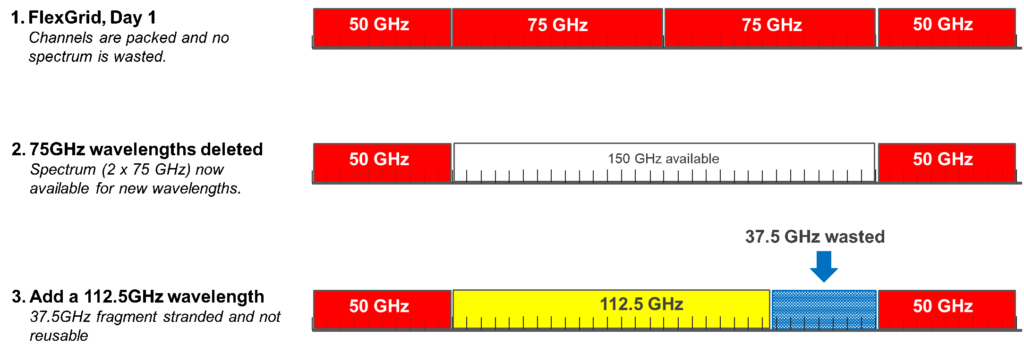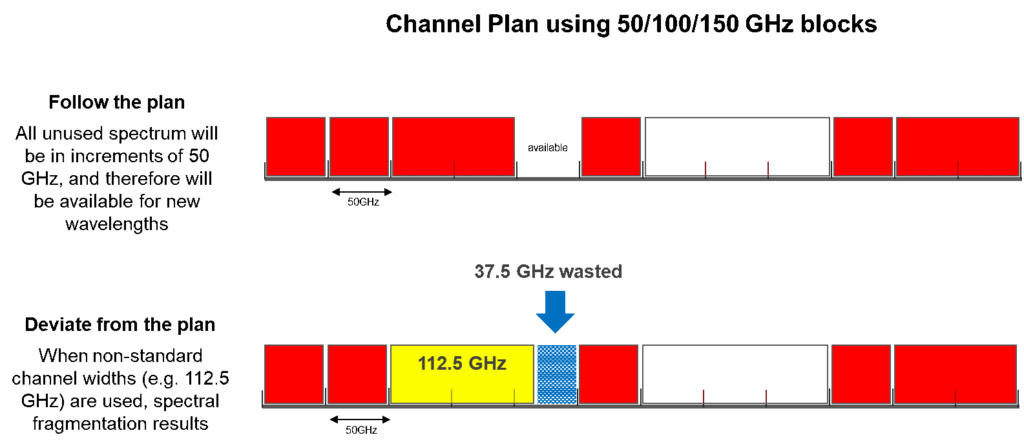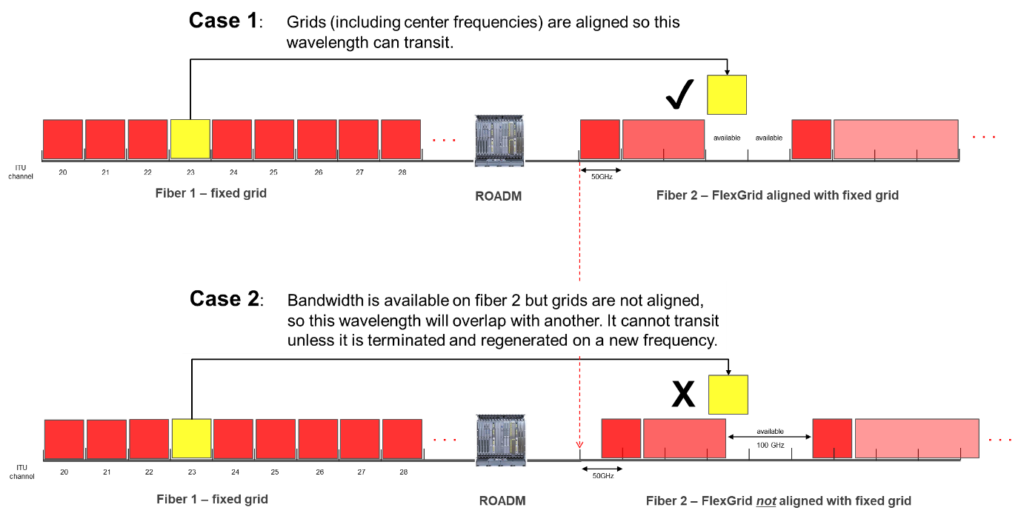
Key Recommendations for Optical Channel Planning in Flex-grid ROADM Networks
The emergence of higher baud rate transponders is fueling the migration from 50GHz fixed grid ROADM networks to Flex-grid, where wavelengths can occupy a variable spectral width in increments of 12.5GHz in width and 6.25GHz in terms of central frequency.
Flex-grid certainly provides service providers with a lot more flexibility in establishing circuits of various rates and distances, as the initial industry hype promised. But as Flex-grid adoption by service providers increases, a number of issues have emerged:
- Spectrum Fragmentation
- Channel Count Reduction
- Backwards Compatibility with Fixed Grid Networks
In this blog I explore the impact of these issues and recommend a few simple guidelines to mitigate their potential negative impacts. A key benefit of Flex-grid is that it is grid-less and “structureless” but introducing a bit of structure will actually help service providers get the most out of their next generation ROADM network.
Spectrum Fragmentation
The first drawback is the emergence of spectrum fragmentation. This occurs when wavelengths of different spectral widths are repeatedly created and deleted, leaving “spectral blocks” which cannot be used. An example of the occurrence of fragmentation is depicted below. Initially all spectrum is occupied but as time goes by, moves, adds and changes occur: the two 75GHz wavelengths are deleted. This frees up 150GHz of spectrum. Later a 112.5GHz wavelength (like those required for 800G transmission) is added. There now exists 37.5GHz of spectrum available – but this fragment is isolated and too small for future use. It is stranded.

Channel Count Reduction
The second potential drawback to Flex-grid is the reduction in the number of available channels. The width of the optical C-Band is fixed to 4.8 THz. This total spectral capacity is shared between all the channels associated to the network’s transponder.
The traditional 50GHz spectral width per channel translates to a total of 96 channels; this implies that fibers could simultaneously transport 96 independent wavelengths.
Flex-grid provide the ability to increase the spectral width of a wavelength in order to increase capacity and/or reachable distance. The increase in spectral width will reduce the total number of available channels. For example, the total number of available channels drops to 32 if a carrier elects to use only 150GHz channels. For a new wavelength to be added, the same channel must be used across all fibers in its path. With fewer channels to choose from, the number of wavelengths with a clear path across the network can be severely limited.
Backwards Compatibility With Fixed Grid Networks
The majority of ROADM networks today still use a fixed grid, and it will be many years before Flex-grid networks become the majority. Hence cases where a wavelength must transit through both Flex and fixed grid networks end-to-end will likely remain a common occurrence for years to come. This is particularly true for metro networks where multiple generations of equipment coexist, which a wavelength must traverse end-to-end.
This implies that any Flex-grid ROADM network should maximize backwards compatibility and align with the fixed grid channel plan in some way.
Use Flex-grid In Moderation
The introduction of Flex-grid initially generated an enthusiastic vision where service providers would have the ability to activate wavelengths of any spectral width, on demand, with little concern about the management of this functionality. Spectral fragmentation was naively envisioned to be swiftly eliminated using a defragmentation tool available at the click of a button – similar to defragging a computer hard drive.
Reality is proving to be more challenging and there is a realization that guidelines need to be applied to the use of Flex-grid capabilities. These guidelines can be summarized as follows.
Recommendation 1: Manage Your Spectrum as a Precious Commodity
Use optical spectrum as a scarce capacity. Always try to use the narrowest spectral width which can successfully transport the requested capacity from point A to point B. For example, if a customer requires a 100G wavelength over a distance of 200km, mapping this traffic into a 50GHz channel is perfectly adequate.
The possible exception to this is when the wavelength’s source or destination ROADMs experience unpredictable or frequent spikes in demand. In this case, due to the high likelihood of multiple circuits, service providers might elect to use a wider spectral width in conjunction with a muxponder. Examples of high traffic demand where this applies are wavelengths between major metro areas.
Alternatively, a circuit between smaller metro areas might not present a compelling reason to oversubscribe spectral width since the likelihood that a future circuit will exactly request these two end points is likely low.
Recommendation 2: Standardize Around a Few Spectral Widths
In order to minimize spectrum fragmentation, service providers should select a few spectral widths and only allow these spectral widths to be used within the network. The 50GHz spectral width must be included as a fundamental building block for two reasons: compatibility with legacy ROADM networks, and the ability to minimize spectrum usage for short distance circuits.
Additional building blocks should be multiples of either 75GHz and/or 50GHz. This recommendation will greatly minimize, if not eliminate, spectral fragmentation. This is because integer multiples of 50GHz will not create any fragments smaller than 50GHz and hence will not lead to small unusable fragments.
A building block analogy can be used to represent this point:

The top figure only allows spectral widths which are a multiple of 50GHz. Wavelengths align nicely with each other and any available spectrum is N x 50GHz wide, which is usable for new wavelengths.
By comparison, the bottom figure includes an additional wavelength with a spectral width of 112.5GHz. This leaves a 37.5GHz gap before the next block. Stranded 37.5GHz blocks are rarely usable and will most likely be wasted. There are rare occasions when wavelengths can be mapped into a 37.5GHz channel, but distance and rates are severely limited.
An alternate (though short-sighted) approach is to assign wavelengths arbitrarily to spectral blocks which are not aligned to the original 50GHz fixed grid (i.e. with different center frequencies). It is true that this will eliminate the unusable 37.5GHz spectral blocks. However, by doing so, the planner forgoes the ability to transport a 50GHz wavelength across an older fixed grid ROADM network. This leads to the third guideline.
Recommendation 3: Align 50GHz Channels to the Fixed Grid Wherever Possible
Networks are rarely truly greenfield. Most network deployments are required to connect with older networks and wavelengths commonly have to flow uninterrupted across sub-networks from different generations. This is especially the case for metro networks where multiple generations of equipment coexist.
This is why it is important to align the Flex-grid 50GHz channels to the traditional 96 channel fixed grid. This is the only way a 50GHz wavelength will be able to traverse from the next generation network to a ROADM network from a previous generation.
Any misalignment would require the wavelength to be terminated and regenerated into a new wavelength at the demarcation point between the two generation’s networks. This additional step of optical-electrical-optical conversions is inefficient and prohibitively costly.
The figure below illustrates this point.

Once the 50GHz channels are aligned with the 96 channel fixed grid, then, any multiple of 50GHz (such as 100GHz and 150GHz) will also be aligned on the correct frequencies. Any other channel size causes the creation of unusable spectrum fragments.
Recommendation 4: Use 75GHz as a Building Block
75GHz channels are the exception to the guidelines above. Since 75GHz is not a multiple of 50GHz, it does not interconnect with the legacy ROADM network and it can lead to the creation of 25GHz unusable spectral blocks.
However, there are a few compelling reasons to use 75GHz as a fundamental spectral width building block just like 50GHz:
- 75GHz is the smallest spectral width with the ability to transport a 400G wavelength across a ROADM network. The traditional 50GHz spectral width is not wide enough to allow transport of 400G beyond a point-to-point connection. 400G traffic will become the next dominant traffic increment is it is important to be able to efficiently transport it using the smallest practical spectral width.
- 400ZR and ZR+ are new coherent optical technologies aimed predominately at short reach, single span networks, and it is anticipated that 75GHz will emerge as the most popular spectral width for this application.
- With careful wavelength allocation, it is possible to let 50GHz and 75GHz coexist in the network while limiting spectral fragmentation to an absolute minimum. These two spectral widths are also integer fractions of 150GHz, which is likely the next popular spectral width increment to transport wavelengths beyond 400G.
- The 75GHz spectral width translates to the availability of 64 channels in the C-Band. This number is sufficiently large to reduce the risk of channel exhaust while still providing a channel wide enough to transport a 400G wavelength across a metro or regional network.
One approach to minimizing spectral fragmentation when using 50GHz and 75GHz building blocks is to divide the C-Band into 32 x 150GHz blocks and assign each block to either transport 3 x 50GHz channels or 2 x 75GHz channels. This logical partitioning guarantees that no 25GHz unusable spectral fragments will be left behind.
Summary
Flex-grid enables 400G wavelengths, allows unrestricted channels plans, and offers powerful new capabilities. However, issues with spectral fragmentation, channel count reduction, and the need for compatibility with fixed grid networks mean that choosing a building block structure with 50GHz and 75GHz blocks will prove beneficial to overall network operation. Getting the most out of valuable optical spectrum requires that Flex-grid be used judiciously, in moderation.
Interested in 400G? The Fujitsu 1FINITY™ T700 transponder provides the capability to map gigabit ethernet traffic to wavelengths from 100G to 400G and spectral widths of 50GHz (compatible with fixed grid networks), 75GHz (in line with recommendation 4) and 87.5GHz (for completely unrestricted channel plans).. The 1FINITY™ T700 features an inverse multiplexing option that splits 400 GbE client traffic into two wavelengths of 200 G, both which can then be transported by fixed grid networks before being recombined at the other end of the circuit.
The ROADM Tutorial Blog Series
In this series of tutorials, Francois Moore explains the key functionality (and their benefits) that underpin next-generation ROADMs: Colorless, Directionless, Contentionless, and Gridless (CDC-G) functionality.